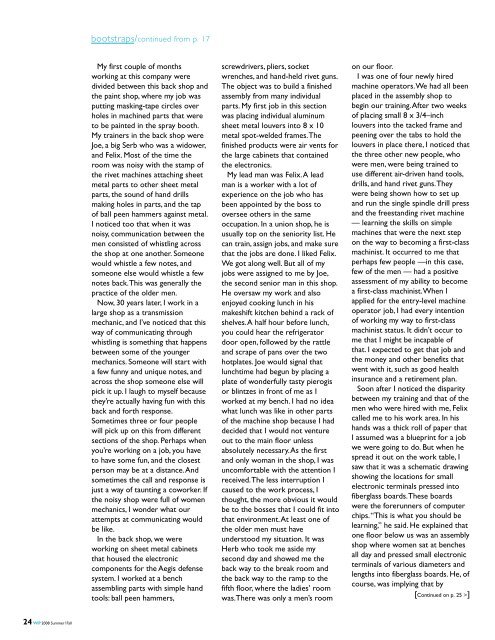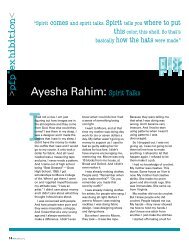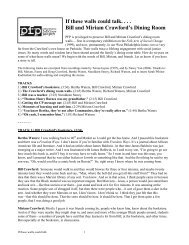View PDF - Philadelphia Folklore Project
View PDF - Philadelphia Folklore Project
View PDF - Philadelphia Folklore Project
Create successful ePaper yourself
Turn your PDF publications into a flip-book with our unique Google optimized e-Paper software.
ootstraps/continued from p. 17<br />
My first couple of months<br />
working at this company were<br />
divided between this back shop and<br />
the paint shop, where my job was<br />
putting masking-tape circles over<br />
holes in machined parts that were<br />
to be painted in the spray booth.<br />
My trainers in the back shop were<br />
Joe, a big Serb who was a widower,<br />
and Felix. Most of the time the<br />
room was noisy with the stamp of<br />
the rivet machines attaching sheet<br />
metal parts to other sheet metal<br />
parts, the sound of hand drills<br />
making holes in parts, and the tap<br />
of ball peen hammers against metal.<br />
I noticed too that when it was<br />
noisy, communication between the<br />
men consisted of whistling across<br />
the shop at one another. Someone<br />
would whistle a few notes, and<br />
someone else would whistle a few<br />
notes back. This was generally the<br />
practice of the older men.<br />
Now, 30 years later, I work in a<br />
large shop as a transmission<br />
mechanic, and I’ve noticed that this<br />
way of communicating through<br />
whistling is something that happens<br />
between some of the younger<br />
mechanics. Someone will start with<br />
a few funny and unique notes, and<br />
across the shop someone else will<br />
pick it up. I laugh to myself because<br />
they’re actually having fun with this<br />
back and forth response.<br />
Sometimes three or four people<br />
will pick up on this from different<br />
sections of the shop. Perhaps when<br />
you’re working on a job, you have<br />
to have some fun, and the closest<br />
person may be at a distance. And<br />
sometimes the call and response is<br />
just a way of taunting a coworker. If<br />
the noisy shop were full of women<br />
mechanics, I wonder what our<br />
attempts at communicating would<br />
be like.<br />
In the back shop, we were<br />
working on sheet metal cabinets<br />
that housed the electronic<br />
components for the Aegis defense<br />
system. I worked at a bench<br />
assembling parts with simple hand<br />
tools: ball peen hammers,<br />
screwdrivers, pliers, socket<br />
wrenches, and hand-held rivet guns.<br />
The object was to build a finished<br />
assembly from many individual<br />
parts. My first job in this section<br />
was placing individual aluminum<br />
sheet metal louvers into 8 x 10<br />
metal spot-welded frames. The<br />
finished products were air vents for<br />
the large cabinets that contained<br />
the electronics.<br />
My lead man was Felix. A lead<br />
man is a worker with a lot of<br />
experience on the job who has<br />
been appointed by the boss to<br />
oversee others in the same<br />
occupation. In a union shop, he is<br />
usually top on the seniority list. He<br />
can train, assign jobs, and make sure<br />
that the jobs are done. I liked Felix.<br />
We got along well. But all of my<br />
jobs were assigned to me by Joe,<br />
the second senior man in this shop.<br />
He oversaw my work and also<br />
enjoyed cooking lunch in his<br />
makeshift kitchen behind a rack of<br />
shelves. A half hour before lunch,<br />
you could hear the refrigerator<br />
door open, followed by the rattle<br />
and scrape of pans over the two<br />
hotplates. Joe would signal that<br />
lunchtime had begun by placing a<br />
plate of wonderfully tasty pierogis<br />
or blintzes in front of me as I<br />
worked at my bench. I had no idea<br />
what lunch was like in other parts<br />
of the machine shop because I had<br />
decided that I would not venture<br />
out to the main floor unless<br />
absolutely necessary. As the first<br />
and only woman in the shop, I was<br />
uncomfortable with the attention I<br />
received. The less interruption I<br />
caused to the work process, I<br />
thought, the more obvious it would<br />
be to the bosses that I could fit into<br />
that environment. At least one of<br />
the older men must have<br />
understood my situation. It was<br />
Herb who took me aside my<br />
second day and showed me the<br />
back way to the break room and<br />
the back way to the ramp to the<br />
fifth floor, where the ladies’ room<br />
was.There was only a men’s room<br />
on our floor.<br />
I was one of four newly hired<br />
machine operators. We had all been<br />
placed in the assembly shop to<br />
begin our training. After two weeks<br />
of placing small 8 x 3/4–inch<br />
louvers into the tacked frame and<br />
peening over the tabs to hold the<br />
louvers in place there, I noticed that<br />
the three other new people, who<br />
were men, were being trained to<br />
use different air-driven hand tools,<br />
drills, and hand rivet guns. They<br />
were being shown how to set up<br />
and run the single spindle drill press<br />
and the freestanding rivet machine<br />
— learning the skills on simple<br />
machines that were the next step<br />
on the way to becoming a first-class<br />
machinist. It occurred to me that<br />
perhaps few people —in this case,<br />
few of the men — had a positive<br />
assessment of my ability to become<br />
a first-class machinist. When I<br />
applied for the entry-level machine<br />
operator job, I had every intention<br />
of working my way to first-class<br />
machinist status. It didn’t occur to<br />
me that I might be incapable of<br />
that. I expected to get that job and<br />
the money and other benefits that<br />
went with it, such as good health<br />
insurance and a retirement plan.<br />
Soon after I noticed the disparity<br />
between my training and that of the<br />
men who were hired with me, Felix<br />
called me to his work area. In his<br />
hands was a thick roll of paper that<br />
I assumed was a blueprint for a job<br />
we were going to do. But when he<br />
spread it out on the work table, I<br />
saw that it was a schematic drawing<br />
showing the locations for small<br />
electronic terminals pressed into<br />
fiberglass boards. These boards<br />
were the forerunners of computer<br />
chips. “This is what you should be<br />
learning,” he said. He explained that<br />
one floor below us was an assembly<br />
shop where women sat at benches<br />
all day and pressed small electronic<br />
terminals of various diameters and<br />
lengths into fiberglass boards. He, of<br />
course, was implying that by<br />
[Continued on p. 25 >]<br />
24 WIP 2008 Summer / Fall














